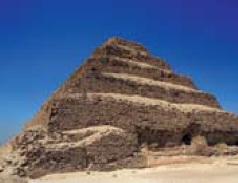The Missing Kingdom: Why Fungi Must Be Central to Conservation Strategy
28 December 2025
Published online 25 June 2010

For centuries, ancient Egypt has captured the imagination of historians, who have worked relentlessly over the years to piece together the history of one of the greatest civilizations. A new study analysing ancient Egyptian artefacts attempts to pinpoint their chronological order more accurately than ever before.
The research, published in the journal Science1, measured radioactive carbon isotopes in 211 samples collected from museums around the world to determine their age. The samples were correlated with certain eras or kings. These data were then used to draw out an accurate estimate of the timeline of ancient Egyptians.
"[The study] hasn't changed the timescales radically — what it has done is remove some of the uncertainty — and it has ruled out some possibilities that have been seriously considered," explained Christopher Ramsey, who is deputy director of the Research Laboratory for Archaeology and the History of Art at the University of Oxford, United Kingdom.
Plants absorb the naturally occurring radioactive carbon-14 isotope during photosynthesis. After they die, the absorbed radioisotope decays naturally according to the carbon's half-life. By measuring the amount of carbon-14 in organic remains, scientists can determine how long ago they were living.
Radiocarbon dating has been used on Egyptian artefacts in the past, but the results were not accurate.
"In ancient Egypt, there was a great deal of reuse of old materials for building and a lot of old organic material finds its way into later contexts — so there has been a tendency for radiocarbon dates to be older than expected. This is most notable for wood and charcoal, where the date reflects the date of growth of the tree and this can in some instances be centuries earlier than the final use of the piece of wood or the final deposition of the charcoal," said Ramsey.
In addition, dating of individual samples yields an accuracy of 100 to 200 years, which is not adequate to fine-tune the timing of important events.
The team, which included researchers from the United Kingdom, France, Austria and Israel, attempted to solve these two particular problems through their three-year-long research. They avoided using samples from wood or charcoal, due to their misleading nature. They also avoided mummified remains, which might be contaminated by materials used in the mummification process.
"For each sample, we undertake an extensive chemical pre-treatment, which is designed to isolate large unchanged macro-molecules from the original sample. There is a lot of background work, measuring duplicate samples between different laboratories, and samples of known age, to try to ensure accuracy," said Ramsey.
All the samples selected were somehow related to the reigns of the kings of the Old, Medium and New Kingdoms. The chronology of the kings was built with help and judgment from excavators and curators.
"This information is put together with the radiocarbon data in a statistical model. This is what gives us much higher precision in our fit of the chronologies onto the calendar time scale," explained Ramsey.

Due to the data used in the research, the study was able to pin down the chronologies of the New Kingdom more accurately than those of the Medium and Old Kingdoms. It manages to settle some date differences that archaeologists have debated for years.
The reign of king Djoser, who is credited with building the first pyramid, the Saqqara pyramid, is estimated through the study to have started between 2691 and 2625 BC. This verifies earlier historical chronologies. "It rules out the lower chronologies, which move the Old Kingdom later in time by about 50 to 100 years," said Ramsey.
The New Kingdom was much more precisely dated, and the research showed that the reigns of the kings of this period, including Tutankhamun, might actually have been about a decade earlier than previously thought.
The start of the Middle Kingdom is often associated with an astronomical sighting of the star Sirius. There was a debate about where the star was observed, which gave the event two different estimates, with 40 years difference between them. The new study favours the older interpretation, which put the start at 2055 BC. However, the researchers quickly add that the radioactive chronology cannot conclusively rule between both interpretations.
The selection of the samples was pivotal for the accuracy of the study. Ramsey and his team had to use samples as small as a grain of wheat in the analysis. In order to study these tiny samples, they used an accelerator mass spectrometer.
The samples had to be collected from museums around the world because, currently, Egypt has a ban on the export of any archaeological material, including seeds and plant remains, for scientific analysis. Although Egypt has a conventional radiocarbon laboratory, it does not have an accelerator mass spectrometer.
"For this reason we were not able to make measurements on current excavations, which would have helped a lot, particularly in improving the precision of the estimates for the Old and Middle Kingdoms. Hopefully in the long run the facilities for making these measurements will be set up in Egypt itself," said Ramsey.
doi:10.1038/nmiddleeast.2010.167
Stay connected: